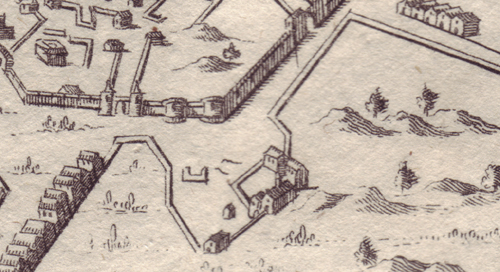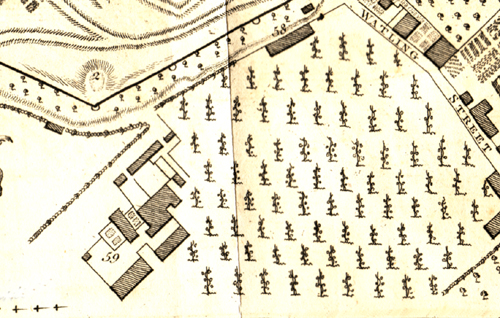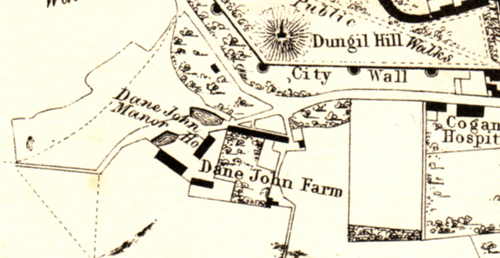
![]()
~DANE JOHN MANOR (Dungeon Manor)~
CANTERBURY
Owned successively by the families of Chiche, Brent, Hales, Lee & Warner - demolished 1752
In 1987, there was still standing, the last of the 16th century buildings of the Dane John Manor. These were made of fine brick with Caen stone quions. The other buildings that had remained, were destroyed when the Railway was built in 1859.

On old map detail possibly showing Dane John Manor

Map detail from William Gostling 1777 of the "Place of Dungel or Dane John Manor House(59)"

Map detail from Felix Summerly 1843 of the "Dane John Manor & Farm"
Dungeon Manor, or Dean John Farm, near the Dane John, was anciently the property of the Chiche family; its present possessor is Geroge Henry Lee Warner. The manor house was called Coventry House. Stuppington Manor also belonged to the Chiche family, is situate near the last mentioned and is now in the possession of Mr. Joseph Royle.1838 directory
The Manor of the Dungeon, the
mansion of which, situated just without the city walls, at a small distance
westward from the lesser hill of the Dungeon, in the parish of St. Mary
Bredin, has been pulled down for some years, and only part of the out-offices
are remaining, with part of the garden walls. This manor, now known
by the name of Deanjohn farm, was formerly the property of an antient
family called Chiche, one of whom, Ernaldus de Chich, was a person of
principal note in the reigns of Henry II. Richard I. and king John,
and the aldermanries of Burgate and Northgate, in this city, being then
held as an estate in fee, did then belong to him and his heirs, and
had continued for some time in his family. Thomas Chiche, who was one
of the bailiffs of Canterbury in 1259, and again in 1271, was a principal
benefactor to the above church of St. Mary Bredin. John Chich was likewise
one of the bailiffs of it in the 23d and 26th years of king Edward III.
In the year 1320, being the 13th of king Edw. II. a definitive sentence
was pronounced by Robert Malling, then commissary of Canterbury, on
the evidence as well of antient deeds and writings as otherwise, that
the hospital of St. Laurence, in Canterbury, was entitled to receive
not only the tithes of this manor, but of three hundred acres of land
likewise adjacent to it; in consideration of which, John Chiche, who
was then lord of this manor, was to receive in autumn for his servants,
five loaves of bread, two pitchers and a half of beer, and half a cheese
of four-pence; and he himself was entitled to receive unum par Chirothecarum
ferinarum, one pair of leather gloves, and one pound of wax in candles;
and for his servants three pair of gloves. Thomas Chich, son of the
above-mentioned John, was sheriff of this county in the 15th year of
king Richard II.'s reign, and kept his shrievalty at the Dungeon; and
his great-grandson Valentine Chich, dying without male issue, this manor
was alienated by him about the beginning of Edward IV.'s reign, to Roger
Brent, gent. who was of the parish of All Saints, in Canterbury, who
died possessed of it, as appears by his will in the Prerogative-office,
in Canterbury, in the year 1486, anno 2 Henry VII. and ordered it to
be sold for the payment of his debts and legacies; after which it appears
by an old court-roll, that in the beginning of the next reign of Henry
VIII. John Boteler, or Butler, of Heronden, in Eastry, was become proprietor
of it, and he passed it away by sale to Sir John Hales, chief baron
of the exchequer; and when Leland visited this part of Kent in the 30th
year of that reign, he then resided at this mansion, which afterwards
descended down to Sir James Hales, of the Dungeon, who died in 1665,
leaving one only daughter and heir Elizabeth, who carried it in marriage
first to Sir Stephen Hales, K.B. of Warwickshire, and secondly to George,
third son of William Sheldon, esq. of Beoly, in Worcestershire, by neither
of whom she had issue. They resided at the Dungeon, where she died in
1678, and as he did a few months afterwards, possessed of this manor
and seat, which his heirs alienated in 1680, to Henry Lee, esq. whose
descendant Thomas Lee Warner, esq. in 1752, pulled down to the ground
this mansion, then known by the name of Donjon, alias the Coventry house
(so called from the lady Coventry's residing in it) leaving only a few
of the offices in the front, and the garden walls standing, and near
them the farmhouse, with the buildings belonging to it. He died possessed
of this estate in 1768, and was succeeded in it by his son Henry Lee
Warner, esq. of Walsingham abbey, in Norfolk, the present owner of it.
. 'Canterbury: Manors', The
History and Topographical Survey of the County of Kent: Volume 11 (1800),
pp. 147-164.

Map detail from 1907 showing the Railway Station where the Manor used to be and all the housing development
The Dungeon, a Manor deriving its Name from the Hill adjoining called Dungeon Hill, but very corruptly, for it appearing by a Survey of the Grounds adjoining, that the Trenches and Hill were intended to promote a Siege; and we reading that the Danes besieged this City in King Ethelred's Days, we have Reason to think it a Work of the Danes, and so is properly called the Danes, or Danian-Hill. This Manor was the Estate of the Chiches, to whom the Aldermanry of Burgate did anciently belong, and who were great Benefactors to the Church of St. Mary Bredin, where are the Arms of the Family, and the Image of Thomas Chich in the West Window, as his name under it shews.
Magna Britannia Antqua & Nova 1738
"The Dungeon Manor, the mansion of which was situated within the city walls, in the parish of St. Mary Bredin, a short distance from the lesser hill of the dungeon; it was long the seat and property of the ancient family Chiche; from this family it was alienated to Roger Brent, gent., who died possessed of it in 1486. In the 30th year of Henry VIII., when Leland visited this part of Kent, Sir John Hales, Chief Baron of the Exchequer, possessed it, and resided in the mansion. From this family it was sold to Henry Lee Esq., whose descendant, Thomas Lee Warner, Esq., pulled down the mansion in the year 1752."
Kent Directory 1847
"Going from Wincheap eastward without the city wall, we see the two little mounts mentioned in chapter II. behind one of which is a range of buildings, once outhouses to the old capital mansion of Dane John."
*The Lord of this Manor being removed to a distant county, and the house so disagreeably situated as not to invite a good tenant, it was pulled down some years ago.
A walk in and about the City of Canterbury: with many observations not hitherto described in any - William Gostling 1777
"This place was esteemed of such consequence, that it gave name to the adjoining manor of the Dungeon."
Hasteds 1793